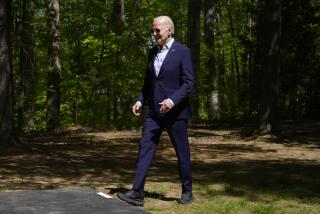Bush Urges Starting Up New Nuclear Plants
Nearly 50 years after President Eisenhower waved a “neutron wand” to ceremonially fire up America’s first atomic power plant, President Bush sought Wednesday to launch a new round of plant construction financed in part with federal dollars.
Bush visited Calvert Cliffs Nuclear Power Plant, one of several sites under consideration by industry and government for a new generation of reactors, to make the case for nuclear power as an essential element of a diversified energy supply.
“Nuclear power is one of America’s safest sources of energy,” said Bush, the first president to set foot in a nuclear plant since Jimmy Carter’s 1979 emergency trip to Three Mile Island after the partial reactor meltdown that helped bring the first round of plant-building in the U.S. to a close.
“It is time for this country to start building nuclear power plants again,” Bush said.
The pitch was part of an ongoing campaign to pressure Congress to pass energy legislation containing many of the provisions first proposed by the Bush White House in 2001. The House has approved a comprehensive energy bill, and the Senate is debating its version this week.
“It’s time for Congress to stop the debate, stop the inaction and pass an energy bill,” Bush said.
The bills contain measures intended to spur construction of nuclear plants. The Senate amended its energy bill this week to add significant incentives, including an operating subsidy of 1.8 cents per kilowatt-hour for new reactors. The bill also contains federal loan guarantees for new reactors and reauthorization of the Price-Anderson Act, which gives the industry legal immunity for nuclear accidents.
Public Citizen, a liberal Washington advocacy group that opposes nuclear power, said the bill provided the nuclear industry with $10.1 billion in tax breaks and subsidies. “Everything the industry wanted is in this bill,” said Michele Boyd, the group’s legislative director for energy.
No new plant projects have been undertaken since the Three Mile Island incident. The more cumbersome licensing procedures adopted in its aftermath, along with the financial toll at the time of double-digit interest rates, caused costs to escalate and investors to flee.
Bush said the 103 operating nuclear plants generated 20% of the nation’s electricity “without producing a single pound of air pollution or greenhouse gases.” He did not mention the lack of a permanent disposal site for spent reactor fuel, which continues to accumulate.
The president said advances in science, engineering and plant design had made nuclear power safer than it was in the 1970s. “There is a growing consensus that more nuclear power will lead to a cleaner, safer nation,” Bush said.
Industry officials applauded Bush’s call to action, but critics of nuclear power said little had changed to justify an infusion of public money or a more accommodative oversight policy.
“They’re looking to revive an all but moribund industry,” said Paul Gunter of the Nuclear Information and Resource Service, which opposes new plants.
“The last effort at building reactors was such a catastrophe that no industry nor Wall Street financier is going to touch this technology without a guarantee that taxpayers will be on the hook.”
Before speaking to an audience of about 400 plant employees and guests, Bush shed his jacket and put on a white plastic safety helmet for a tour of the Calvert Cliffs turbine deck.
He spent several minutes inside the turbine control room, where employees operated the steam turbines that used heat from the plant’s twin reactors to generate 20% of the electricity consumed in Maryland.
Bush’s trip came 47 years after Eisenhower brandished his neutron wand -- actually a ceremonial shaft outfitted with a light bulb -- to dedicate the first nuclear power plant in May 1958. While Eisenhower was in Washington, the plant he opened was in Shippingport, Pa. Part of Eisenhower’s Atoms for Peace program, the plant was decommissioned and dismantled in the 1980s.
Times staff writer Ralph Vartabedian contributed to this report from Los Angeles.
More to Read
Start your day right
Sign up for Essential California for news, features and recommendations from the L.A. Times and beyond in your inbox six days a week.
You may occasionally receive promotional content from the Los Angeles Times.






